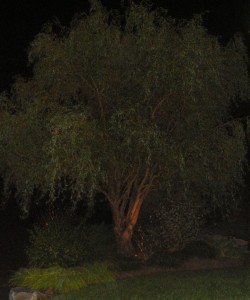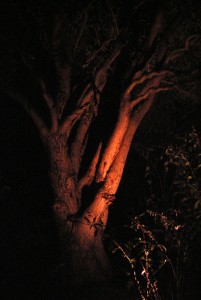With the days getting shorter, I thought it would be a great time to talk about garden lighting. The kind I would like to highlight are the ones beyond the normal entry door lights and post lamps, and move further into the garden. There are so many types out there to choose from, and they can really enhance your landscape as well as provide some safety.
Whether you choose hardwired, low-voltage, or solar here are some things to consider. With hardwired you need some electrical knowledge, permits, and may need to bury your lines quite deeply, to pass code. Usually the hardwired lights are installed during a new build, but can be added later. Solar has come a long way in the past few decades, and has some clear advantages in some applications. You can easily find kits with multiple pathway lights, deck post-cap lights, and even stair tread lights in solar. About the only drawback is that you must get six or more hours of sun on the panels each day for them to work, and the light that they cast is not very bright, but is good for guiding your way as an accessory to a brighter light source. That leaves us with low-voltage, which I personally think is the best. It is consumer friendly being easy to install, and very flexible. You can change your layout as needed without to much effort. Also, you can determine what wattage is best for your personal application.
Low-voltage is the type that we chose for our yard, and my husband installed it more than a decade ago. We have changed it around a few times, and learned a lot about what works best. Here are some helpful tips he wanted to share.
* When you are planning your lighting layout add up your total wattage and get a transformer that is the next size up. That way if you want to change it around, or add an extra light or two you will have the capacity.
* Up-lighting is truly a great way to highlight your house. To do this place the spotlights about 2-3 ft. away from the foundation with a slight angle toward to house. It will highlight the brick or siding and bathe your house in glow, a real professional look.
* When highlighting a tree, aim the light about half way up the trunk. It will cast light up into the branches, and highlight the bark.
* When connecting the individual lights to the main wire, leave the junction above ground. Even though it is “waterproof,” the connectors are the weakest link, and are usually the first part needing to be checked.
* We have found that using 40-50 watt bulbs works best for us, the lower wattage is just to dim to cast light beyond a few feet. Also, please be considerate and do not aim your lighting beyond your property line.
* For safety’s sake make sure to light your property’s address number, in an emergency it could make a difference!
I hope you will add some lighting to your garden, you will be amazed at how much beauty it adds.



Leave a Reply